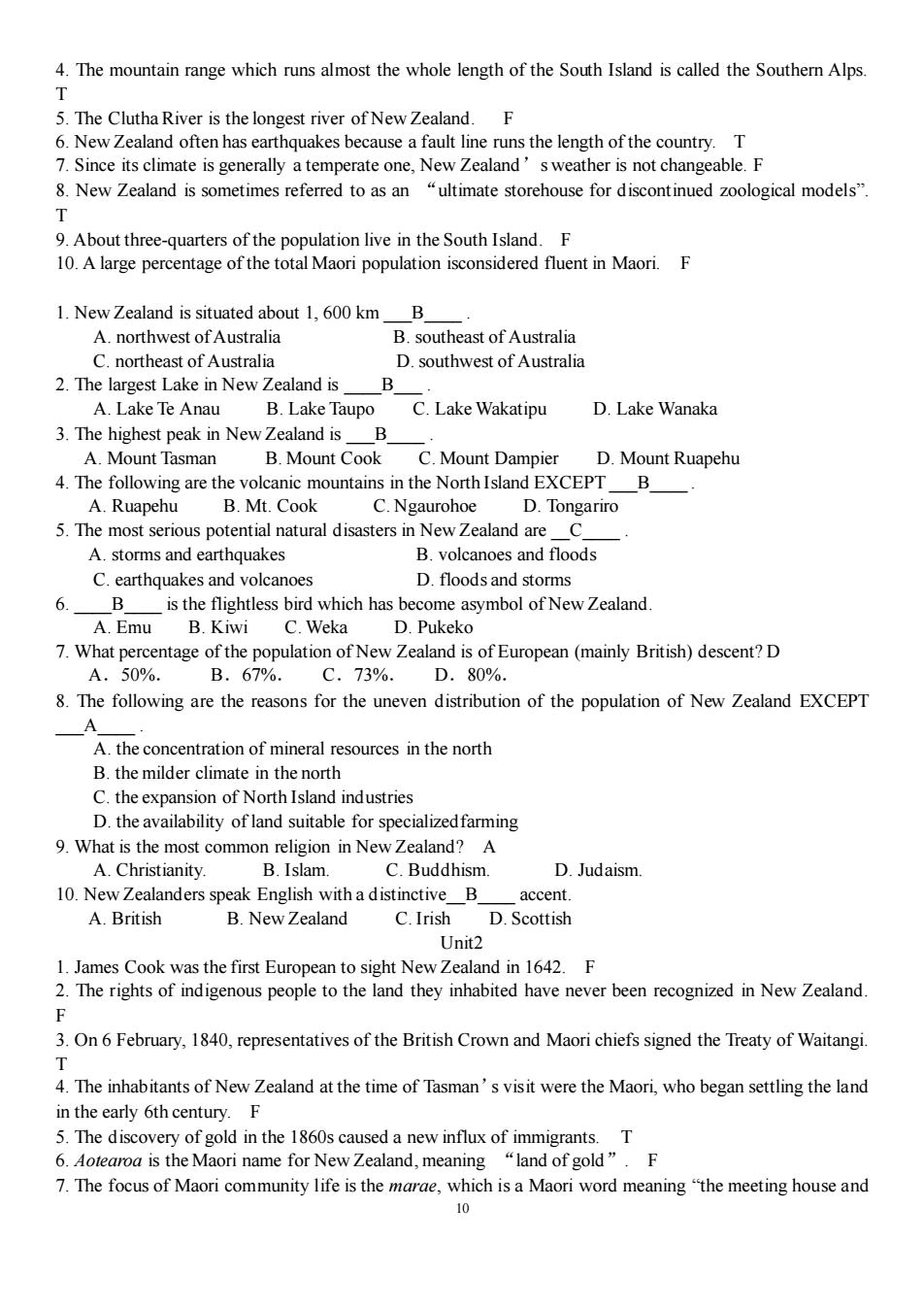正在加载图片...

4.The mountain range which runs almost the whole length of the South Island is called the Southern Alps 5.The Clutha River is the longest river of New Zealand. 6.New Zealand often has earthquakes because a fault line runs the length of the country.T 7.Since its climate is generally a temperate one,New Zealand's weather is not changeable.F 8.New Zealand is sometimes referred to as an "ultimate storehouse for discontinued zoological models" 9.About three-quarters of the population live in the South Island.F 10.A large percentage of the total Maori population isconsidered fluent in Maori.F 1.New Zealand is situated about 1,600 km B_ A.northwest ofAustralia B.southeast of Australia C.northea t of Au D.southwest of Australia 2.The largest Lake in New Zealand is B A.Lake Te Anau B.Lake Taupo C.Lake Wakatipu D.Lake Wanaka 3.The highest peak in New Zealand is B A Mount Tasman B Mount Cook C mount dampier D.Mount Ruapehu 4.The followi A.Ruapehu ni mountains in the North Island EXCEPT B 5.The most serious potential natural disasters in New Zealand areC. a storms and earthquakes B.volcanoes and floods c earthauakes and volcanoes D floods and storms 6 D is the flightless bird which has bec asymbol of Ne w Zealand A.Emu B.Kiwi C.Weka D.Pukeko 7.What percentage of the population of New Zealand is of European(mainly British)descent?D A.50%. B.67%. C.73%. D.80%. 8.The following are the reasons for the uneven distribution of the population of New Zealand EXCEPT A.the co eentration of mineral resources in the north B.the milder climate in the north C.the expansion of North Island industries D.the availability of land suitable for specializedfarming 9.What is the most common religion in New Zealand?A B.Islam C Buddhism D.Judaism 10.NewZelanders speak English witha distinctive B accent A.British B.New Zealand C.Irish D.Scottish Unit2 1.James Cook was the first European to sight New Zealand in 1642.F 2.The rights of indigenous people to the land they inhabited have never been recognized in New Zealand. 3.On6 February,1840,representatives of the British Crown and Maori chiefs signed the Treaty of Waitangi. 4.The inhabitants of New Zealand at the time of Tasman's visit were the Maori,who began settling the land in the early 6th century.F 5.The discoveryf ld in the 1860s ca .F 7.The focus of Maori community life is the marae,which is a Maori word meaning"the meeting house and 1010 4. The mountain range which runs almost the whole length of the South Island is called the Southern Alps. T 5. The Clutha River is the longest river of New Zealand. F 6. New Zealand often has earthquakes because a fault line runs the length of the country. T 7. Since its climate is generally a temperate one, New Zealand’s weather is not changeable. F 8. New Zealand is sometimes referred to as an “ultimate storehouse for discontinued zoological models”. T 9. About three-quarters of the population live in the South Island. F 10. A large percentage of the total Maori population isconsidered fluent in Maori. F 1. New Zealand is situated about 1, 600 km ___B____ . A. northwest of Australia B. southeast of Australia C. northeast of Australia D. southwest of Australia 2. The largest Lake in New Zealand is ____B___ . A. Lake Te Anau B. Lake Taupo C. Lake Wakatipu D. Lake Wanaka 3. The highest peak in New Zealand is ___B____ . A. Mount Tasman B. Mount Cook C. Mount Dampier D. Mount Ruapehu 4. The following are the volcanic mountains in the North Island EXCEPT ___B____ . A. Ruapehu B. Mt. Cook C. Ngaurohoe D. Tongariro 5. The most serious potential natural disasters in New Zealand are __C____ . A. storms and earthquakes B. volcanoes and floods C. earthquakes and volcanoes D. floods and storms 6. ____B____ is the flightless bird which has become asymbol of New Zealand. A. Emu B. Kiwi C. Weka D. Pukeko 7. What percentage of the population of New Zealand is of European (mainly British) descent? D A.50%. B.67%. C.73%. D.80%. 8. The following are the reasons for the uneven distribution of the population of New Zealand EXCEPT ___A____ . A. the concentration of mineral resources in the north B. the milder climate in the north C. the expansion of North Island industries D. the availability of land suitable for specializedfarming 9. What is the most common religion in New Zealand? A A. Christianity. B. Islam. C. Buddhism. D. Judaism. 10. New Zealanders speak English with a distinctive__B____ accent. A. British B. New Zealand C. Irish D. Scottish Unit2 1. James Cook was the first European to sight New Zealand in 1642. F 2. The rights of indigenous people to the land they inhabited have never been recognized in New Zealand. F 3. On 6 February, 1840, representatives of the British Crown and Maori chiefs signed the Treaty of Waitangi. T 4. The inhabitants of New Zealand at the time of Tasman’s visit were the Maori, who began settling the land in the early 6th century. F 5. The discovery of gold in the 1860s caused a new influx of immigrants. T 6. Aotearoa is the Maori name for New Zealand, meaning “land of gold”. F 7. The focus of Maori community life is the marae, which is a Maori word meaning “the meeting house and